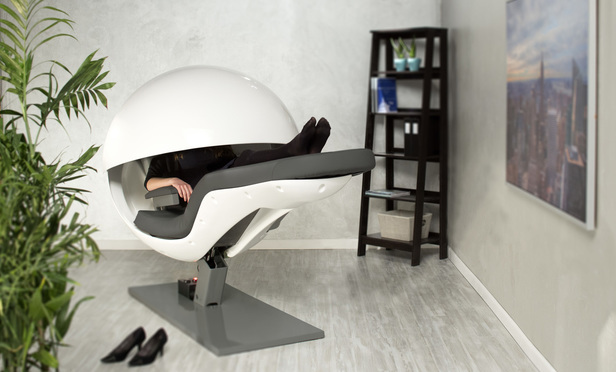 (Photo: Adam Watstein/MetroNaps)
(Photo: Adam Watstein/MetroNaps)
Too pooped to finish that brief? There’s a nap for that.
They’re called “energy pods,” and White & Case has two of them in its D.C. office. At $13,000 a pop, they’re not cheap, but the rewards of better productivity and lawyer satisfaction pay off, fans say.
We’ve all been there. You’re at the office, it’s 3:30 in the afternoon and you’re so drowsy you could weep. To chase away the sandman, some people grab a cup of strong coffee; others head to the vending machine for a bag of Funyuns. But embracing that urge to sleep on the job by spending 20 minutes in a napping chamber may be the most effective strategy.
“It’s like ‘Wow, I’m refreshed,’ ” said Francis Vasquez Jr., a White & Case litigation and arbitration partner who worked with the office’s associates to get the napping pods installed last year.
The models White & Case bought are manufactured by MetroNaps, a New York-based company that sells “ the world’s first chair designed for napping in the workplace,” as its website touts. Think of them as lounge chairs with a dome or “privacy visor.” You can listen to “relaxation rhythms” provided by the machine or drift off to your own tunes in cozy seclusion. After 20 minutes, the pod gently nudges you awake with vibrations and soft lights.
Vasquez said It was at associates’ urging that White & Case bought the pods, but he’s used one a few times in the morning. He gets to the office early after taking his children to school and has crawled into one of the pods to grab a cat nap before the day gets underway.
“They look like little spaceships,” he said.
Other businesses that use MetroNaps’ “corporate fatigue management solutions” include Google Inc., Cisco Systems Inc. and PriceWaterhouseCoopers LLP. The company has been around for 10 years, but only “a handful” of law firms have been customers, said CEO Christopher Lindholst, who holds a master’s in business from Columbia University. The other law firms are small, he said, and he declined to provide their names. “It’s not been a significant vertical for us,” he said.
It makes sense for law firms to have them, he said, because of attorneys’ notoriously long work days, but law firm leaders, especially older partners, get hung up on the notion of nodding off while on the clock.
“There are certain, let’s say industries or institutions, that are more conservative in their thinking about this,” Lindholst said. “We think it’s going to take a full generation to fully shake off the stigma associated with sleeping on the job.”
By providing napping pods, law firms don’t have to worry about their lawyers losing billables because “associates can sleep just enough to avoid issues like seizures or psychosis,” said psychoanalyst Will Meyerhofer, a former associate at Sullivan & Cromwell. “All humor aside, I doubt firms are going to go all ‘new age’ with sleeping pods.”
White & Case set up its new pods when the D.C. office underwent a renovation two years ago. They’re in a room separated from the rest of the office and partitioned by screens. They’re available for attorneys and staff to use.
The setup is “Zenlike,” Vasquez said, with dim lights, a small rock waterfall and walls painted in a “soothing” pale green. “They do take up a good chunk of space,” he said.
For organizations unwilling to fork over $13,000 per pod, they can lease the equipment for $1,995 down and $160 a month. They only come in one model and color—white, Lindholst said. “Otherwise, people go into committee over ‘do we want red or purple?’”
At White & Case, the pods have been well-received, Vasquez said, although workers have not been lining up to use them.
“People don’t want to admit that they’re the ones using them,” he said. “I think because it’s new.”
Contact Leigh Jones at [email protected]. On Twitter: @LeighJones711




